MailMerge: Data Structures Explained with a Sample Template and JSON Data
The MailMerge class is used to merge JSON data into templates including merge fields and repeating merge blocks. This article gives an overview of the data structure based on a sample template with JSON data.

The Mail
This article explains the data structure based on a simple template and sample JSON data.
The Sample JSON Data
The sample JSON data contains hierarchical data that allows to show different mail merge features including access to data from child tables and nested, repeating merge blocks.
[
{
"company_name": "Text Control, LLC",
"address":
{
"street": "1111 Text Control Way",
"zip": "28226",
"city": "Charlotte",
"country": "United States"
},
"contacts": [
{
"name": "Tim Typer",
"email": "tim@textcontrol.com"
},
{
"name": "Karl Keyboard",
"email": "karl@textcontrol.com"
},
{
"name": "Petra Paragraph",
"email": "petra@textcontrol.com"
}
],
"orders": [
{
"id": 123,
"articles": [
{
"id": 1,
"product": {
"name": "Product A",
"description": "Description of product A",
"price": 200
},
"qty": 5,
"discount": 0.2
},
{
"id": 2,
"product": {
"name": "Product B",
"description": "Description of product B",
"price": 244
},
"qty": 50,
"discount": 0.0
},
{
"id": 3,
"product": {
"name": "Product C",
"description": "Description of product C",
"price": 677
},
"qty": 2,
"discount": 0.5
}
]
},
{
"id": 321,
"articles": [
{
"id": 1,
"product": {
"name": "Product B",
"description": "Description of product B",
"price": 123
},
"qty": 12,
"discount": 0.0
},
{
"id": 2,
"product": {
"name": "Product D",
"description": "Description of product D",
"price": 556
},
"qty": 2,
"discount": 0.7
},
{
"id": 3,
"product": {
"name": "Product C",
"description": "Description of product C",
"price": 677
},
"qty": 20,
"discount": 0.3
}
]
}
]
}
]Internally, the hierarchical structure is converted into tables. The following diagram shows these tables including their child tables:
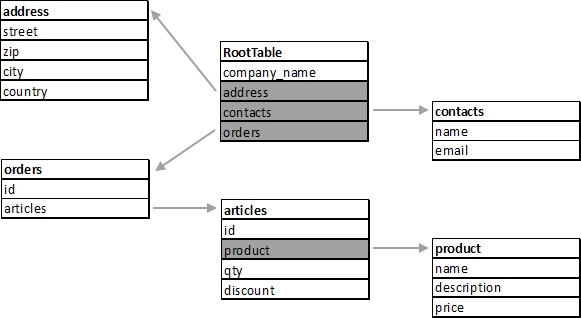
The Sample Template
The sample template that is used in this article is very simple and contains static data, simple merge fields and a nested, repeating block. The merge block will list all "orders" from the sample data:
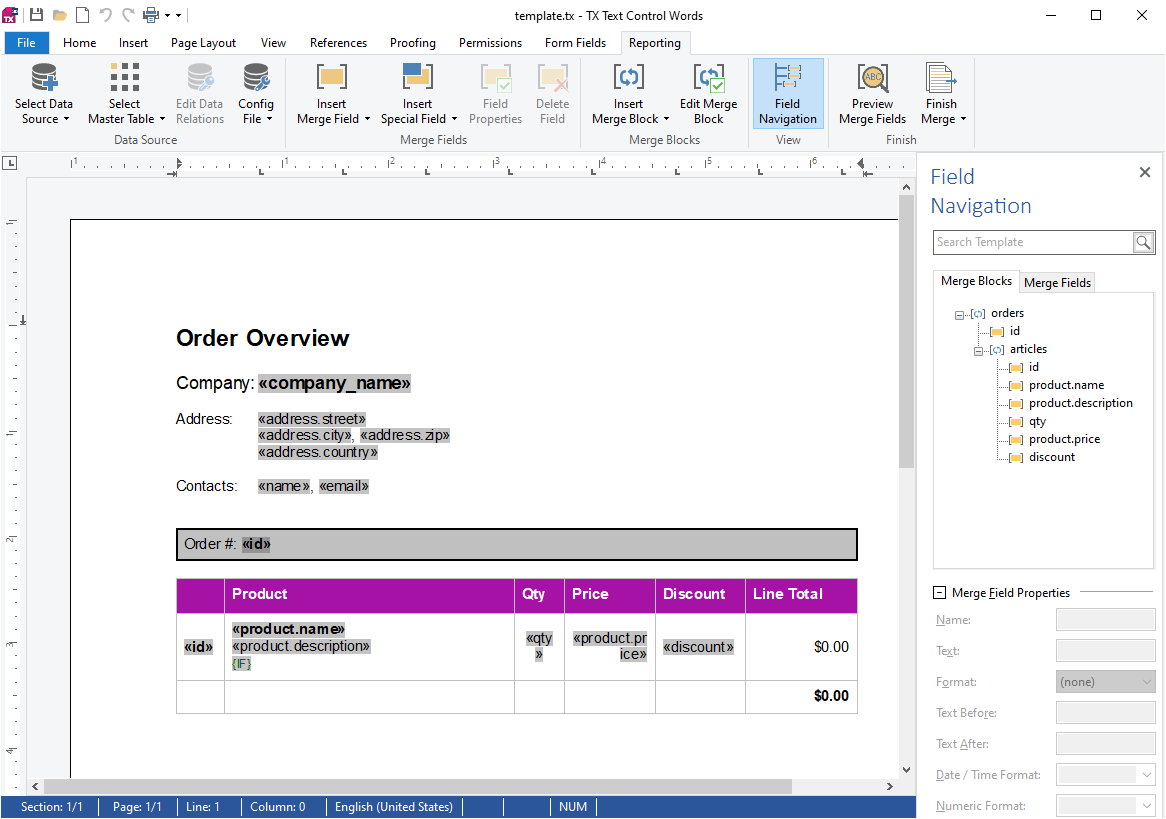
First, we take a look at the address part of the template. For this part, 3 tables are used and accessed in different ways.

Accessing Child Tables
company_name comes from the root table directly while the address is coming from a child table. These fields can be accessed using the "dot notation". For example, to access the street, the merge field name is address.street.
The contacts part contains a merge block (highlighted in red below) to list all of the contacts. A merge block repeats all elements part of the block based on the data for this block. In this case, the block includes a soft break and the tab character, so that all contacts are listed at the same indent position:
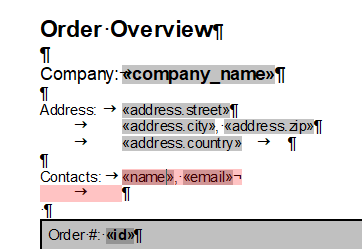
The following animation shows the header section before and after the merge process:
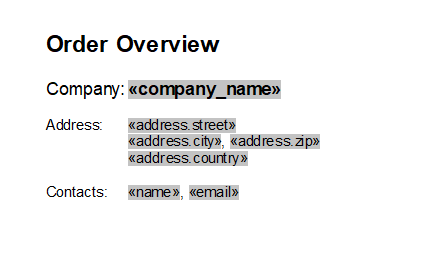
Repeating Blocks
The detail section lists all orders and their articles. Therefore, two nested merge blocks are inserted. The outer block repeats the orders objects and the inner block lists all articles:
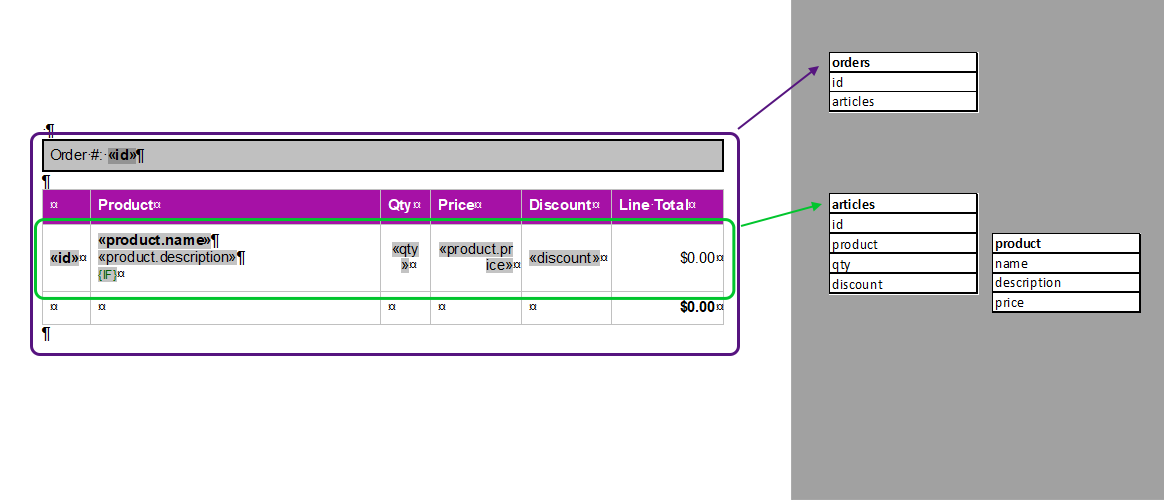
As can be seen in the following animation, the outer block is getting repeated 2 times based on the actual data in the given JSON. The inner table row is defined as the nested block articles and contains all line items:
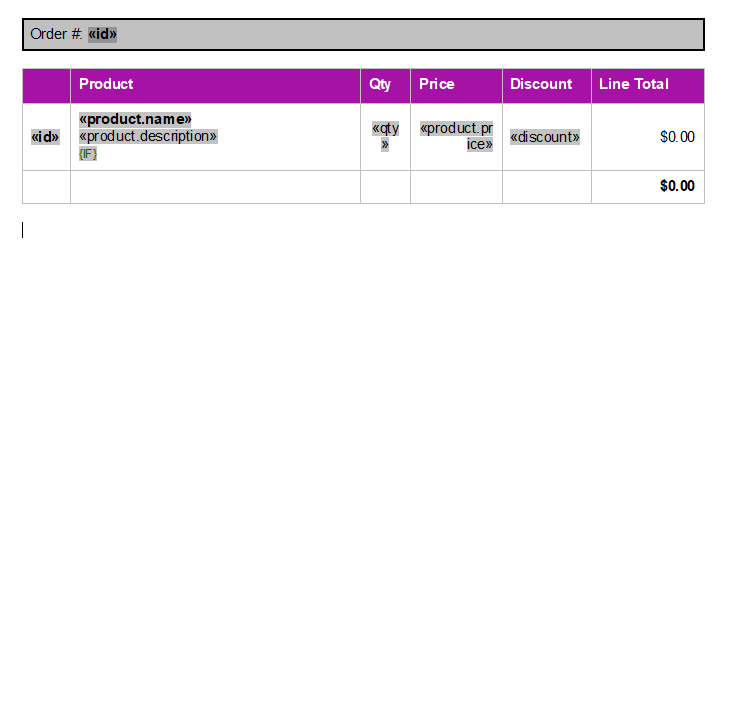
Using Dynamic Formulas in Merge Blocks
Several values are calculated on-the-fly and are not part of the JSON data:
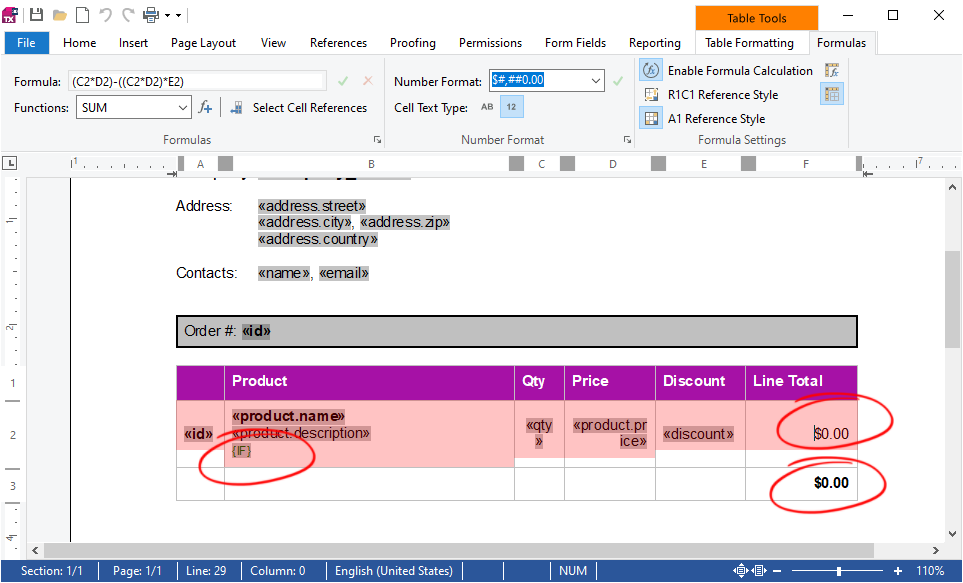
The line total and the total sum values are calculated based on table cell formulas. The line total multiplies the qty with the product.price including the given discount. The total sum formula simply creates a sum of all values above in the same column of the table.
The IF field prints the text "This item is discounted!" in cases the discount is larger than 20%.
Download Sample Data
Download the sample template and the JSON data and test this on your own.
Also See
This post references the following in the documentation:
- TXText
Control. Document Server. Mail Merge Class
ASP.NET
Integrate document processing into your applications to create documents such as PDFs and MS Word documents, including client-side document editing, viewing, and electronic signatures.
- Angular
- Blazor
- React
- JavaScript
- ASP.NET MVC, ASP.NET Core, and WebForms
Related Posts
Renaming Merge Blocks and Merge Fields Programmatically in C#
This article shows how to programmatically rename merge blocks and merge fields in a document using TX Text Control .NET for Windows Forms, WPF, and ASP.NET. It implements a helper class that can…
MailMerge: Merging Hyperlinks using the FieldMerged Event
The MailMerge class is used to merge data into merge fields, image placeholders, barcodes and other reporting elements. With the help of the flexible FieldMerged event, additional elements can be…
Mail Merge MS Word Office Open XML (DOCX) Templates in C#
TX Text Control's MailMerge engine allows you to perform MS Word compatible mail merge processes in .NET based applications. This article gives an overview of the basic functionality and shows how…
MailMerge: Field Mapping and Handling of Unmerged Fields
Text Control's MailMerge API maps merge fields in templates with columns in supported data sources. This article explains the structure and how to handle unmerged fields.
Adding Sorting and Filter Instructions to Existing MergeBlocks
Merge blocks can be filtered and sorted with linked instructions that help to shape the used data in each merge block. This article shows how to add sorting and filter instructions to existing…






